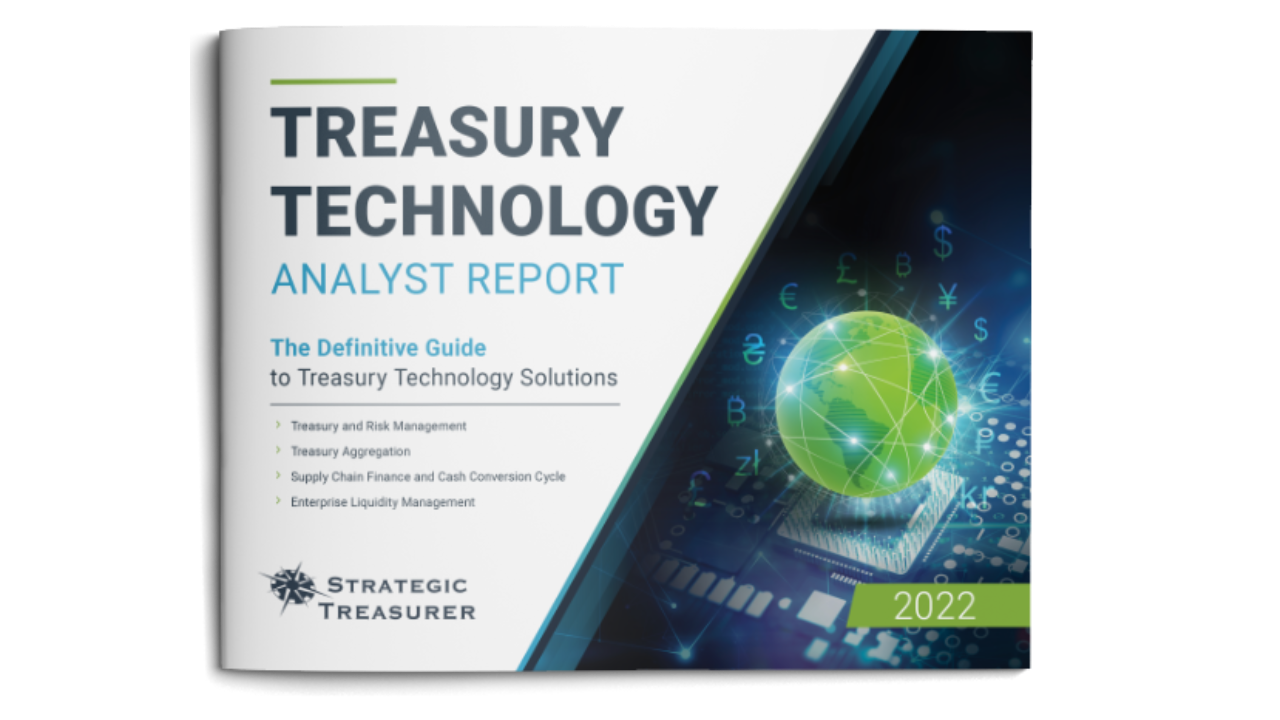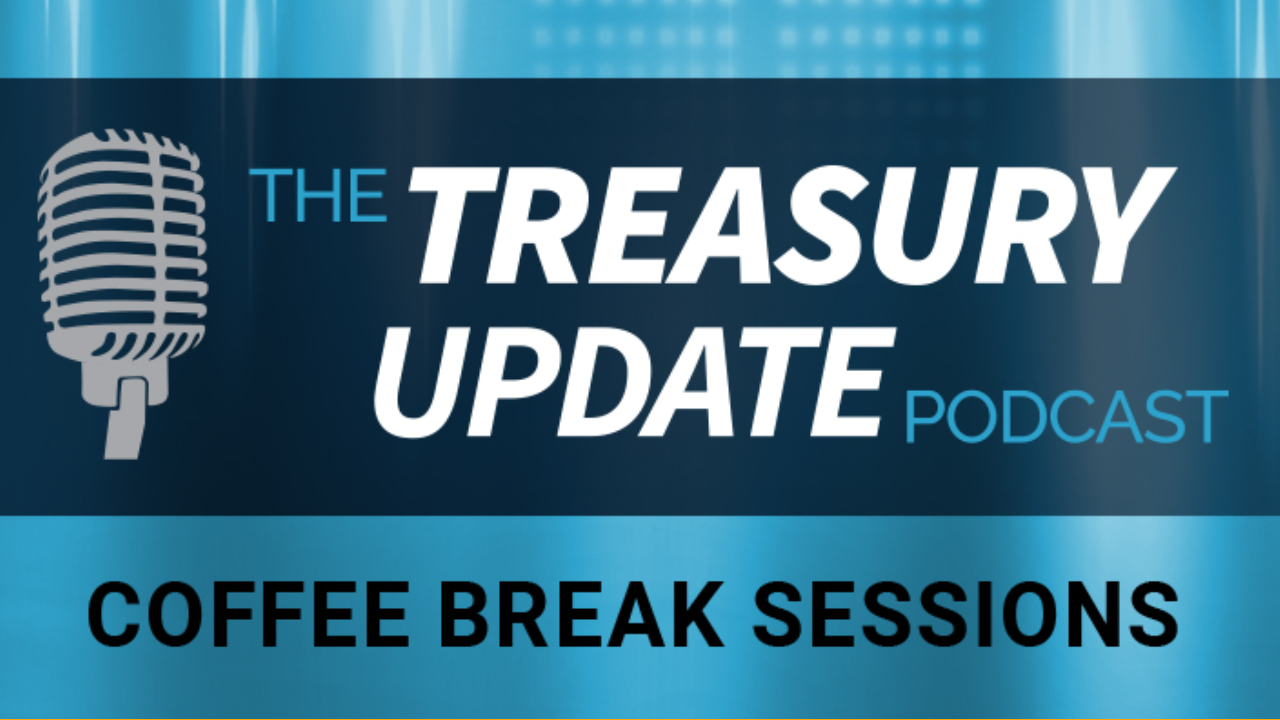
Session 89
Coffee Break Session: What Is Counterparty Risk?
In today’s Coffee Break Session, Jason Campbell and Craig Jeffery have a conversation on counterparty risk. They delve into the fundamentals of counterparty risk, its significance to businesses, and effective management strategies. Are you equipped to safeguard your business from these potential pitfalls? Listen in to learn more.
Host:
Jason Campbell, Strategic Treasurer


Speaker:
Craig Jeffery, Strategic Treasurer


Episode Transcription - (Coffee Break Session Series) - Episode 89 - What Is Counterparty Risk?
Jason Campbell 00:03
Welcome to the Treasury Update Podcast, Coffee Break Session presented by Strategic Treasurer covering foundational topics and core treasury issues, in about the same amount of time it takes you to drink your cup of coffee. I’ll be your host Jason Campbell, business development leader as Strategic Treasurer. Welcome to another great episode of the coffee break sessions. I’m your host, Jason Campbell. And joining me today is our managing partner and founder of Strategic Treasurer, Craig Jeffery. Craig, welcome to the show.
Craig Jeffery 00:30
It’s good to be here. Jason, I’m glad that you know it’s a great show before we start.
Jason Campbell 00:35
It’s coming up in my almost my year of doing the Coffee Break Session. So and I don’t think I’ve had a bad one yet that I know of. So I’m gonna go with every show is going to be great from here on out. Yeah, this is where I’m gonna do it. But today on this session here, we’re gonna talk about an interesting topic where you and I have kind of had some some dialogue and conversation around this previously and felt it would be a good topic to talk to our listeners about here is a little bit about counterparty risk. And I know in some of the webinars we’ve hosted and polling questions or what some topics, folks would want to hear from us, and this come up actually quite a few times. So I’m kind of intrigued to really hear your subject matter expertise in this. So let’s kick it off and talk about Craig, our listeners. Let’s walk through, what is counterparty risk?
Craig Jeffery 01:20
So counterparty risk is, you know, risk is some type of exposure to some type of unfortunate or expected or unhoped for event. Counterparty is the other side of a transaction or who’s who you’re who you have some exposure to. So counterparty risk is oftentimes thought of if you have some kind of bond offering or settlement that’s occurring, the other party fails to complete their transaction. Counterparty risk is broader than that as well. It’s any any of those types of exposures. So it could be balances that you have in bank accounts, it could be a line of credit, and what if the bank cannot fund that, or you have a payment coming due. You have some kind of investments and then the paying party doesn’t pay you. There’s a there’s a range of these these items that fall into the category of counterparty risk. More recently, what’s been in the news is main concerns about banks. And if you have uninsured deposits, you know, they’re not covered by FDIC or some other insurance agency. If the bank fails, anything above the insured limit is potentially at risk. And you’re at risk for not getting paid or at risk for getting a portion of those funds over a long period of time, and so being tied up with that. So it’s the it’s the risk you face from counterparties. Now there’s vendors or counterparties customers or counterparties. You know, vendors it might be they don’t, they can’t provide you goods or materials, actually they’re providing you money. Customers, they don’t pay you, they delay pay paying you for some period of time, and then certainly financial firms, so what we spoke about.
Jason Campbell 03:00
So I guess from a standpoint of looking at it from the angle is, counterparty can be considered like that, like you said, the other side of that transaction, and just knowing that everything hopefully goes smooth, but also trying to put in your planning is the what ifs, right, the contingencies, and just keeping an eye on and ensuring that wherever the funds are aligned on the other side is in a safe place, and that the measures have been put into play to ensure that protection is key, right? So why does this matter?
Craig Jeffery 03:27
Well, it matters because the loss of the loss of funds are not being able to complete transactions. So you know, you have you put an investment out there, you’re expecting safety of principle on some type of reasonable yield for your return, and then you don’t get those funds back. And so concerns over the US not paying interest when it comes due, was a recent recent discussion, but also, you know, corporate bond holders, are we gonna get our payments, those are those types of concerns. But to the point earlier, well, it matters to on the bank side, if you have significant operating flows through a bank account, the bank becomes insolvent, and you have you know, 20 million 50 million, whatever the number is above the insured limit, you have a real exposure to that type of loss. You also have an exposure to the operational concerns how to keep paying and receiving funds on a regular basis. So this, this matters greatly. It’s just it’s about operational risk and financial risk kind of tied up together. We think about bank accounts on the counterparty risk front.
Jason Campbell 04:29
Going back to this thing and you know, talking about a bad day, right? Bad day being like you I couldn’t even fathom, you know, having these $30, $40 $50 million or whatever, just money in general locked into a bank that if the bank is all of a sudden goes insolvent. I can’t get to that money. Right. Well, that’s a bad day. I don’t know about anybody else, but I think that’s a pretty good one that would probably warrant a definitely outside scream for sure.
Craig Jeffery 04:56
Well, and it was and when we’re looking at Thursday for Silicon Valley Bank, that Thursday when $42 billion was moved out of that bank to other banks like very quickly, and then there was this freezing of the activity, like people couldn’t move funds, there was too much traffic happening. And then over the weekend, people like, how am I going to make payroll? What am I going to do? Because my funds are there, I can’t access them, or it’s above the limits, there’s a lot of a lot of hyper, hyper concerns there for for good reason. So yeah, that can be a very, very bad day.
Jason Campbell 05:29
So, so some advice, though, on your on your end here, you know, how do companies manage this?
Craig Jeffery 05:36
How do they or how should they?
Jason Campbell 05:38
I can be both. It could be a two point question. So I think you can probably hit on both sides.
Craig Jeffery 05:42
So how do they is a lot of you know, think about how you manage risk, it’s usually accept the risk, alter the risk, or avoid the risk. And you can alter the risk by changing how you do business. It could be alternate with financial instruments. You know, that that can be the case, there’s also ignore, and far too often companies, and people ignore the risks that exist. Oh, that’s so unlikely to happen, we’re not going to look at it. And so when you say, how do companies manage this? Well, many don’t do much in the way of counterparty risk management across the board. They look and our banks are fine, they’re going to be covered. They’re not doing any regular monitoring, they don’t necessarily go through a thoughtful, organized process of what are our exposures, identifying those finding some way to calibrate those? What’s the risk level? What’s our tolerance for, you know, some type of loss? You’re not going to split up all of your operating activity to 500 banks and keep your limits under 250,000. But how do you identify the risk level? And then how do you move some that risk off? In the case of balances of banks, you know, what, what’s the level that’s above what’s insured, and what are you comfortable with bearing, and then what are what are you not? So exposure identification. What are exposures? To what counterparties? How hard is it to move? And do we have a plan and the ability to move this quickly? Like so many people who are frantically wiring $42 billion out of the bank, we’re talking about this calibration of saying, what what do I have that’s that’s not covered? It’s one thing to say I have 5 million here. 250,000 is covered by FDIC insurance. I’ve got a backstop. What about the other 4.7 5 million? Am I just exposed for a short time and I can get out the next day. So if there’s I start to get a whiff of trouble I can I can move and diversify. Do I put that into particular investments where I hold the securities as opposed to I’m exposed to the banks so I’m only exposed to the securities, maybe their government issued debt, T bills, what have you? Those are those are some ways that people help adjust that, calibrate the risk. What am I doing? What is my net overall exposure? And so when we think about exposure to counterparties, and operational exposure, most people nowadays are thinking of I need multiple banks. So I think about what are companies doing with actually managing the counterparty risk, it’s not formal in many cases, like I said earlier. It’s less than half of companies have a formal detailed plan for managing their counterparties. On the financial side, they’re like, Oh, we’ve got it an a big bank, it’s extremely informal. We have we ever funds here, there, or it’s not a big enough risk to do anything about it. They haven’t gone through the process and said, Here is where we’re exposed. Here are the limits. Here’s what we’re comfortable bearing versus altering through operational changes or altering through financial instruments. More than half aren’t doing that. And that’s the, that’s the problem. Everyone should be a little more formal in that that should have been done had been consistent, certainly after the 2008 2009 financial crisis. But when those issues started happening with banks became more apparent, the central banks were raising rates very rapidly, that created significant challenges for a number of banks. Not really being willing to look at counterparty risk only in the panic of the moment, is not a particularly good strategy. So they should they should be, what were our exposures? What are the level exposures that we’re willing to take? What do we need to do with the others? How do we do that? So ignore except alternatively, too many are doing ignore accepting risk can be just fine. Does that fall into our capacity? Altering those risks, like okay, I have multiple banks, I move my investments above a certain amount into some other type of investment vehicle so I’m not exposed to a particular financial institution. Or I avoid it. I avoid certain types of scenarios where I say this, this creates too much of a risk environment. You know, some some people buy credit default swaps. or they’ll they’ll, they’ll monitor things not only what the risk level is, from a historical perspective, but they’ll use things like the DuPont model or other methods of of looking at what the exposures to bank are capturing other data points.
Jason Campbell 10:16
So the biggest thing is, you know, I think a good key takeaway on this in this episode would be to you know, are you know, when’s the last time you’ve done that health check? And obviously, you don’t want to ignore as things to happen as we can see, and when we think everything is fine is typically when, unfortunately, bad events sometimes occur. So, and for our listeners, if there’s situations where potentially you’re not sure what direction you may need to take, you know, we have their services. There’s companies out there, like Strategic Treasure, that you can lean on for more advice, or, you know, more direction on that piece of it. Craig, thank you so much for joining us today. We greatly appreciate it. And to our listeners, please remember to tune in every first and third Thursday of the month for a new episode of Coffee Break Session. And if any questions comments, want to drop us a note, please send us an email at podcast@strategictreasurer.com And until next time, take care. Thank you.
Announcer 11:09
This podcast is provided for informational purposes only, and statements made by Strategic Treasurer LLC on this podcast are not intended as legal, business, consulting, or tax advice. For more information, visit and bookmark StrategicTreasurer.com.
Access Your Definitive Guide to Treasury Technology.
Researching new treasury and finance technology can be overwhelming. Strategic Treasurer has stepped in to help. Explore our definitive guide to the treasury technology landscape and discover detailed, data-based coverage of:
- Treasury & Risk Management Systems
- Treasury Aggregators
- Supply Chain Finance & Cash Conversion Cycle
- Enterprise Liquidity Management
Learn more about these technologies and evaluate some of the top vendors in each industry.




